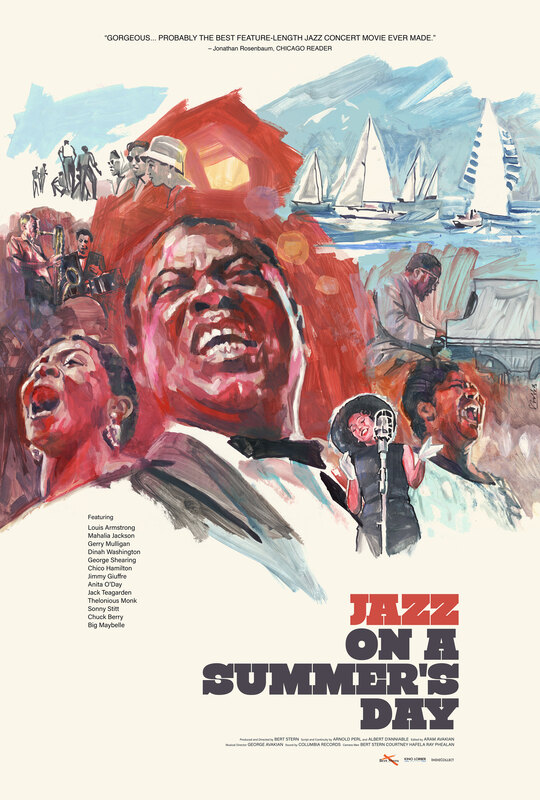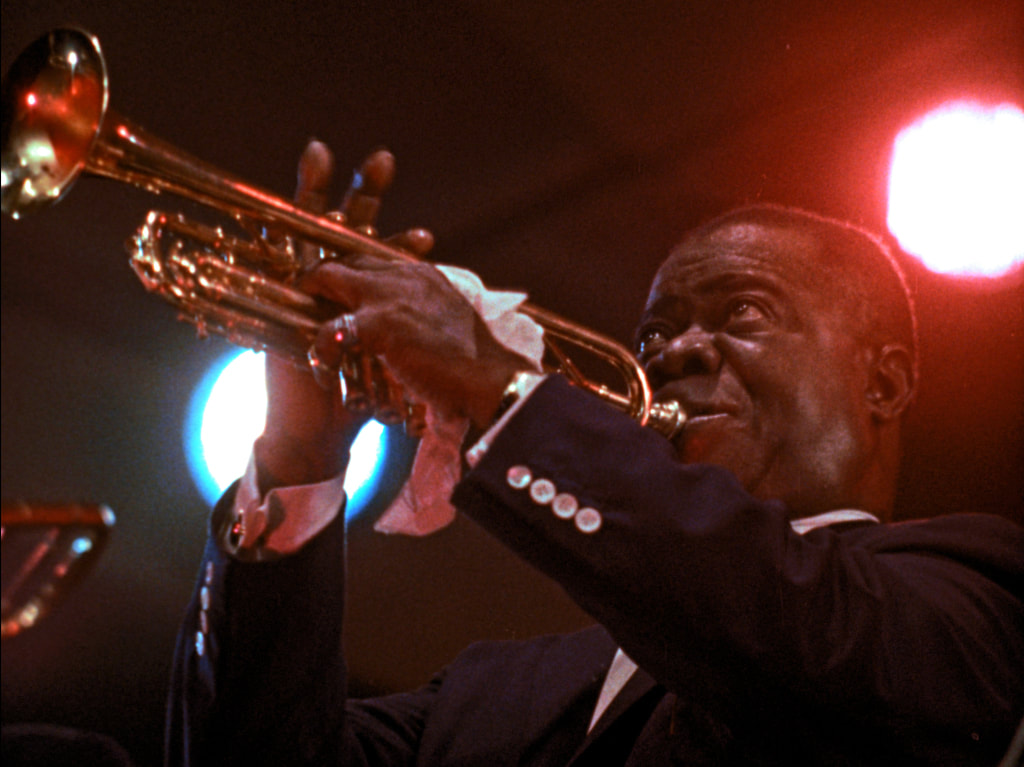After Hours Virtual Cinema

Jazz on a Summer's Day
By Ed Symkus | Telegram.com
Documentary | 85 Minutes | Not Rated
Released in the U.S. to glowing reviews in March 1960, “Jazz on a Summer’s Day,” the 85-minute film made at the 1958 Newport Jazz Festival, boldly breaks many “rules” of documentaries: There’s no story at its center, cameras keep jumping away from its main subjects, it’s much more impressionistic than focused. And all of that works to its advantage.
No one watching this gorgeously restored edition of it is going to come away convinced that they knew what the 1958 Newport Jazz Festival was all about. They’ll have seen and heard only snatches of it, gotten a taste of its many delicious flavors. In tossing out the documentary rulebook, the directors were free to insert a whole song here, and a piece of a different performance there. A group could be playing onstage, with the cameras trained on them, but midway through the song, though it’s still heard on the soundtrack, the cameras might decide to see what else was going on away from the stage: a static shot of buildings in downtown Newport, a glimpse of sailboats taking part in the concurrent America’s Cup Trials, an audience member spellbound by a song, two audience members up and dancing.
Jazz fans need not worry that there isn’t enough music on display. The film opens with some artsy water shots, then jumps to the cool sounds of “The Train on the River,” and a static closeup of tenor saxophonist Jimmy Giuffre and trombonist Bob Brookmeyer playing it (with guitarist Jim Hall off camera).
It’s followed by an offstage introduction of pianist Thelonious Monk, who offers up a fine version of “Blue Monk” with his trio. Then there’s Sonny Stitt playing “Loose Walk” and Chico Hamilton doing “Blue Sands.”
By that point, it’s clear that this isn’t just a documentary, it’s a jazz documentary, and the rules that it’s making up as it goes along are those of a jazz performance. The directors are riffing, improvising within their own art form. Think of it as freewheeling, loose filmmaking.
There’s a fan in the audience with an 8mm movie camera, there’s another one eating a hotdog, here come some more sailboats. And then fashionably dressed Anita O’Day — white gloves and all — takes the stage and has a ball singing and scatting “Sweet Georgia Brown” and a very hip “Tea for Two.”
There’s unexpected intimacy in scenes of musicians rehearsing in Newport houses and a great sense of humor on display at a big party. Suddenly, there’s vocalist Dinah Washington letting loose with a showstopping “All of Me,” then baritone sax-man Gerry Mulligan and trumpeter Art Framer kicking up the excitement level on “Catch as Catch Can.”
There’s some jazz, there’s some blues, and then, with a Gibson electric guitar strapped on, practically glowing under the stage lights, there is Chuck Berry, slogging it a little at first, then getting into the groove of “Sweet Little Sixteen,” which had hit the rock charts a few months earlier. It might have felt out of place for some of the more staid jazz fans, but the film shows most of the folks in the seats lapping it up.
Pace-wise, it’s probably a mistake to follow Berry’s unfettered performance with the comparatively low key one by the Chico Hamilton Quintet. But after the screen fades to black, it lights back up, in pure delight, with four songs by Louis Armstrong and His All-Stars. A hilarious stage interview with the trumpeter-vocalist leads to a lively “Up a Lazy River,” a hot “Tiger Rag,” a soulful vocal duet with trombonist Jack Teagarden on “Old Rockin’ Chair,” and a wild “When the Saints Go Marching In.”
Things wind down with a couple of upbeat, feel-good gospel tunes by Mahalia Jackson, and wrap up with her powerful and moving a cappella version of “The Lord’s Prayer.” It’s a fitting way to end the film, but esthetically speaking, I would have flipped performances and gone out with Louis Armstrong’s bursts of joy.
Tickets for Jazz on a Summer's Day: $12. All sales will help support the After Hours Film Society as we navigate the challenges of COVID-19.
By Ed Symkus | Telegram.com
Documentary | 85 Minutes | Not Rated
Released in the U.S. to glowing reviews in March 1960, “Jazz on a Summer’s Day,” the 85-minute film made at the 1958 Newport Jazz Festival, boldly breaks many “rules” of documentaries: There’s no story at its center, cameras keep jumping away from its main subjects, it’s much more impressionistic than focused. And all of that works to its advantage.
No one watching this gorgeously restored edition of it is going to come away convinced that they knew what the 1958 Newport Jazz Festival was all about. They’ll have seen and heard only snatches of it, gotten a taste of its many delicious flavors. In tossing out the documentary rulebook, the directors were free to insert a whole song here, and a piece of a different performance there. A group could be playing onstage, with the cameras trained on them, but midway through the song, though it’s still heard on the soundtrack, the cameras might decide to see what else was going on away from the stage: a static shot of buildings in downtown Newport, a glimpse of sailboats taking part in the concurrent America’s Cup Trials, an audience member spellbound by a song, two audience members up and dancing.
Jazz fans need not worry that there isn’t enough music on display. The film opens with some artsy water shots, then jumps to the cool sounds of “The Train on the River,” and a static closeup of tenor saxophonist Jimmy Giuffre and trombonist Bob Brookmeyer playing it (with guitarist Jim Hall off camera).
It’s followed by an offstage introduction of pianist Thelonious Monk, who offers up a fine version of “Blue Monk” with his trio. Then there’s Sonny Stitt playing “Loose Walk” and Chico Hamilton doing “Blue Sands.”
By that point, it’s clear that this isn’t just a documentary, it’s a jazz documentary, and the rules that it’s making up as it goes along are those of a jazz performance. The directors are riffing, improvising within their own art form. Think of it as freewheeling, loose filmmaking.
There’s a fan in the audience with an 8mm movie camera, there’s another one eating a hotdog, here come some more sailboats. And then fashionably dressed Anita O’Day — white gloves and all — takes the stage and has a ball singing and scatting “Sweet Georgia Brown” and a very hip “Tea for Two.”
There’s unexpected intimacy in scenes of musicians rehearsing in Newport houses and a great sense of humor on display at a big party. Suddenly, there’s vocalist Dinah Washington letting loose with a showstopping “All of Me,” then baritone sax-man Gerry Mulligan and trumpeter Art Framer kicking up the excitement level on “Catch as Catch Can.”
There’s some jazz, there’s some blues, and then, with a Gibson electric guitar strapped on, practically glowing under the stage lights, there is Chuck Berry, slogging it a little at first, then getting into the groove of “Sweet Little Sixteen,” which had hit the rock charts a few months earlier. It might have felt out of place for some of the more staid jazz fans, but the film shows most of the folks in the seats lapping it up.
Pace-wise, it’s probably a mistake to follow Berry’s unfettered performance with the comparatively low key one by the Chico Hamilton Quintet. But after the screen fades to black, it lights back up, in pure delight, with four songs by Louis Armstrong and His All-Stars. A hilarious stage interview with the trumpeter-vocalist leads to a lively “Up a Lazy River,” a hot “Tiger Rag,” a soulful vocal duet with trombonist Jack Teagarden on “Old Rockin’ Chair,” and a wild “When the Saints Go Marching In.”
Things wind down with a couple of upbeat, feel-good gospel tunes by Mahalia Jackson, and wrap up with her powerful and moving a cappella version of “The Lord’s Prayer.” It’s a fitting way to end the film, but esthetically speaking, I would have flipped performances and gone out with Louis Armstrong’s bursts of joy.
Tickets for Jazz on a Summer's Day: $12. All sales will help support the After Hours Film Society as we navigate the challenges of COVID-19.









